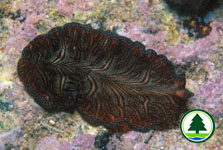
Pseudobiceros bedfordi
(Pseudocerotidae) |
This distinctively colourful flatworm is one of the most common flatworms seen in Hong Kong and the Indo-Pacific. Sometimes, you may find them swimming in the water column with a beautiful, undulating motion. It mainly feeds on tunicates and crustaceans.
|
| |
| Phylum Annelida - Polychaetes and other worms |
| |
|
Phylum Annelida consists of three major groups that include terrestrial (e.g. earthworms), freshwater (e.g. leeches) and marine species (e.g. polychaetes). The distinguishing characteristic of an annelid is the segmented body.
Annelid is divided into a linear series of similar segments from the head to the tail. Growth involves formation of a new segment anterior to the tail. The head bears sensory organs for processing environmental information.
Most of the polychaetes are marine dwellers. They are extremely abundant and widespread in the ocean. Many of them are benthic (e.g. bristle worms), while some are pelagic and tube-dwelling (e.g. fan-worms). With different body forms, polychaetes feed in different ways, such as deposit feeding, filter feeding and raptorial feeding.
Polychaete species usually seen by divers are those that reside in a calcareous tube and have colorful tentacle crowns. The tentacle crowns extend from the tube for gas exchange and ciliary suspension feeding. All belong to the family Serpulidae.
|
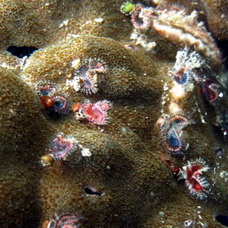
Spirobranchus tetraceros |
| Spirobranchus tetraceros is a close relative of the christmas tree worm commonly found in tropical waters. They possess two colourful tentacle crowns which are flat rather than spiral-shaped. This species is commonly found as a group of individuals on massive corals such as Porites, Montipora and Platygyra in Hong Kong. |
| |
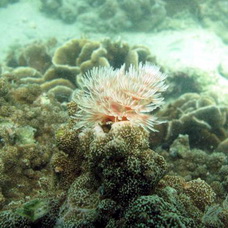 Protula bispiralis Protula bispiralis |
| The Coco Worm, Protula bispiralis, inhabiting a large tube of up to 20 cm long and 1 cm wide, has two pinkish spiral tentacle crowns. This species is usually solitary and is common throughout the tropical Pacific reefs. |
| |
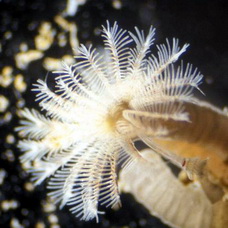 Hydroides elegans Hydroides elegans |
| Hydroides elegans, a small worm with a tube of up to 2.5 cm long and 0.1 cm wide, is the most common species on shallow hard structures throughout the tropical Pacific. The photo shows the tube, tentacle crown and operculum that can close the tube following withdrawal of the tentacles. |
| |
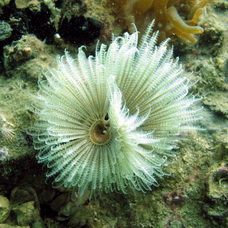 Sabellastarte japonica Sabellastarte japonica |
| Fan worms belong to family Sabellidae. Like serpulids, they have two tentacle crowns, but their tube is parchment-like and covered with mud debris. They usually live on dead corals or in coral sand, with their tentacle crowns extending into the water column. The feather duster Sabellastarte japonica is a common sabellid in local coral communities. This species is usually solitary, found in rock crevices or sand. |
| |
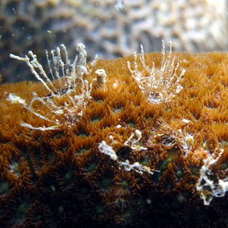 Pherusa parmata Pherusa parmata |
| Instead of living inside a tube, some polychaetes bore into live corals directly. One of such species associated with living massive corals in Hong Kong is the flabelligerid worm Pherusa parmata. This species has a cephalic cage composed of about 30 long chaetae, which can be extended into the water to capture food. The surface of the chaetae is often coated with fine mud. |
| |
| Some polychaetes are common inhabitants of corals, but they are cryptic and are normally not visible unless being extracted from coral sand or broken coral skeleton. Among them are highly mobile nereidids, eunicids, phylodocids and polynoids. |
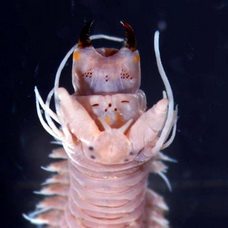 Perinereis cultrifera Perinereis cultrifera |
| The photo shows the anterior part of Perinereis cultrifera with an everted pharynx. The head possesses eyes, sensory palps and tentacles. Each segment of the body bears a pair of parapodia. |
| |
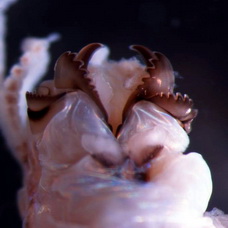 Ventral view of Eunice antennata Ventral view of Eunice antennata |
| The ventral view of Eunice antennata shows the chitinised jaw plates of the partly everted pharynx. |
| |
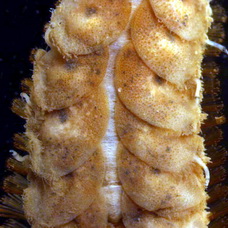 Dorsum of Lepidonotus squamatus Dorsum of Lepidonotus squamatus |
| The polynoids, commonly known as “scale worms”, have an arched back that is covered by a series of overlapping leaf-like “scales”. Scale worms are predators of small animals. Some species are commensals of corals, sea stars and sea anemones. Others are commonly found in crevices or under stones on the sea bottom. The photo shows the dorsum of Lepidonotus squamatus. Each segment is covered by a pair of “scales”. On the sides are dosal cirri and chaetae. |
| |
 Chloeia bimaculata (Amphinomidae) Chloeia bimaculata (Amphinomidae) |
| The two mid-dorsal dark spots arranged one behind the other on each segment of the body distinguish this fire worm from the others. In living specimens the two dark spots are often connected by a thin line, forming a dumbbell-shaped mark. The bristles on the parapodia (feet) are filled with venom, which will cause a burning pain when touched. It can be seen crawling along the sandy sea bottom in search of prey, or occasionally, swimming in the water column. |
| |
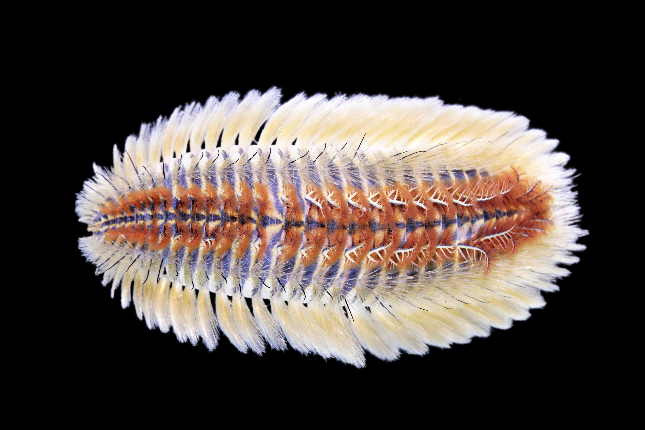 Chloeia parva (Amphinomidae) Chloeia parva (Amphinomidae) |
| This species can be identified with the dark-coloured pattern appears to be an inverted triangle on each segment of the body. They inhabit in the subtidal and intertidal soft bottom. Previous outbreaks of this species were reported on swimming beaches in the spring and summer times, which has been reported to cause itching, redness, swelling and blisters to swimmers who accidentally touched them. |
| |
| Acknowledgment: The above photos are provided by Prof. Jian-wen Qiu, Department of Biology, Hong Kong Baptist University, unless otherwise stated. |
![]()
![]()